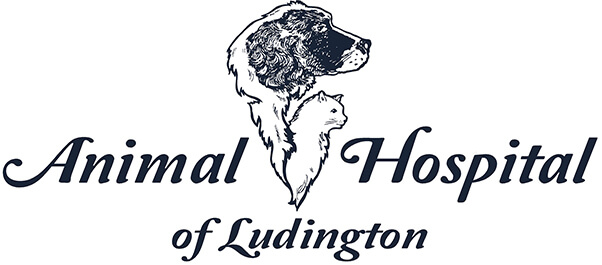Ultrasound
New to the Animal Hospital of Ludington!
We are excited to introduce ultrasound as a new non-invasive imaging diagnostic tool to our practice! Ultrasound works by sending a beam of sound waves through a handheld device called a transducer. As the sound waves encounter structures (like internal organs, fluid, air, etc.), they are reflected back to the probe and converted to an ultrasound image. There is no discomfort for a patient receiving an ultrasound and there are no health risks associated with exposure to ultrasound, making it an amazing diagnostic method.
What is ultrasound useful for?
You may be familiar with the use of ultrasound in human medicine. We use ultrasound in veterinary medicine for the same purposes! Ultrasound excels at evaluating the internal organs such as the heart, liver, spleen, kidneys, pancreas, prostate, adrenal glands, lymph nodes, and bladder. With color doppler on the ultrasound, we can also evaluate the blood supply to these organs or any areas of abnormalities. This makes ultrasound one of the most valuable tools for evaluating a patient’s painful or distended abdomen and looking into the cause of abnormal laboratory values.
Cancer of the spleen can be detected early enough to allow for surgical removal before it has the opportunity to spread. Certain bladder stones that do not show up on X-Ray can be found using ultrasound. Puppies’ heart rates can be monitored during pregnancy. Gall bladder or kidney stones, chronic kidney and liver disease, inflammatory bowel disease, and other chronic conditions can all be monitored through non-invasive ultrasound imaging, allowing for optional personalized treatment plans for your pet.
Minimally invasive ultrasound guided tissue sampling is also useful for the diagnosis of many conditions. We can get cells from abnormal organs or masses and frequently make a diagnosis from these cells, all without the risks of surgery. We are very excited to have this wonderful tool at our disposal to help keep our patients healthy!
X-Rays vs. Ultrasound
We’re talking a lot about ultrasound to look at the chest and abdomen, so you may be wondering: What about the good old X-Ray? And you would be right! X-rays (radiographs) are also used to evaluate the chest and abdomen, but they give us different diagnostic information than ultrasound. Depending on individual cases and goals, radiographs or ultrasound can be prioritized. Frequently, radiographs and ultrasound are used together to get the most information possible on the health of a patient.
With radiographs, we might see an enlarged spleen and no evidence of masses within the lungs, so the next step might involve surgery to remove the spleen. With ultrasound, you can identify a singular mass on the head of the spleen and make sure the liver and surrounding areas are free of tumors to ensure the best outcome from surgical removal of the spleen. These imaging modalities complement each other’s strengths and weaknesses and using them together helps your pet’s medical team (including you!) make the best decisions for your pet.
Discover the Power of Ultrasound in Veterinary Care at Animal Hospital of Ludington
We are thrilled to introduce the cutting-edge technology of ultrasound imaging to our practice! At Animal Hospital of Ludington, we are committed to providing the highest standard of care for your beloved pets, and we believe that incorporating ultrasound into our diagnostic arsenal takes that commitment to a whole new level.
Why Ultrasound?
Ultrasound has revolutionized the field of veterinary medicine, enabling us to visualize the internal structures of your pet’s body with remarkable clarity and precision. This non-invasive imaging modality allows us to capture detailed real-time images of organs, tissues, and blood flow, empowering us to make accurate diagnoses and develop targeted treatment plans.
The Benefits of Ultrasound:
- Early Detection and Diagnosis: Ultrasound enables us to detect subtle changes in your pet’s organs or tissues at an early stage. This early detection can be critical in identifying underlying conditions before they become more severe, leading to better treatment outcomes.
- Non-Invasive and Safe: Unlike other imaging techniques, ultrasound is non-invasive and does not require anesthesia or radiation exposure. This means a safer and more comfortable experience for your furry companion.
- Comprehensive Diagnostic Capabilities: From evaluating abdominal organs, such as the liver, kidneys, and spleen, to assessing cardiac function and detecting tumors, ultrasound provides a comprehensive view of your pet’s internal health. It allows us to investigate a wide range of conditions, including gastrointestinal abnormalities, urinary tract issues, pregnancy evaluations, and much more.
- Guided Procedures: Ultrasound also serves as an invaluable tool during procedures such as biopsies and fluid collection. Real-time imaging helps us precisely target the affected area, minimizing invasiveness and maximizing accuracy.
- Enhanced Client Communication: With ultrasound, we can visually demonstrate and explain your pet’s condition, providing you with a clearer understanding of the diagnosis. This empowers you to make more informed decisions regarding your pet’s treatment options.
Partner with Us for Exceptional Veterinary Care:
When it comes to your pet’s health, we believe in going above and beyond. By incorporating ultrasound into our practice, we are committed to providing comprehensive and advanced veterinary care that exceeds your expectations.
If you have any concerns about your pet’s health or want to explore the benefits of ultrasound, we encourage you to schedule an appointment with our skilled veterinary team. We look forward to discussing how ultrasound can contribute to the well-being of your furry family member. Your pet’s health is our top priority, and we are excited to embark on this journey of advanced diagnostics and enhanced care together!











